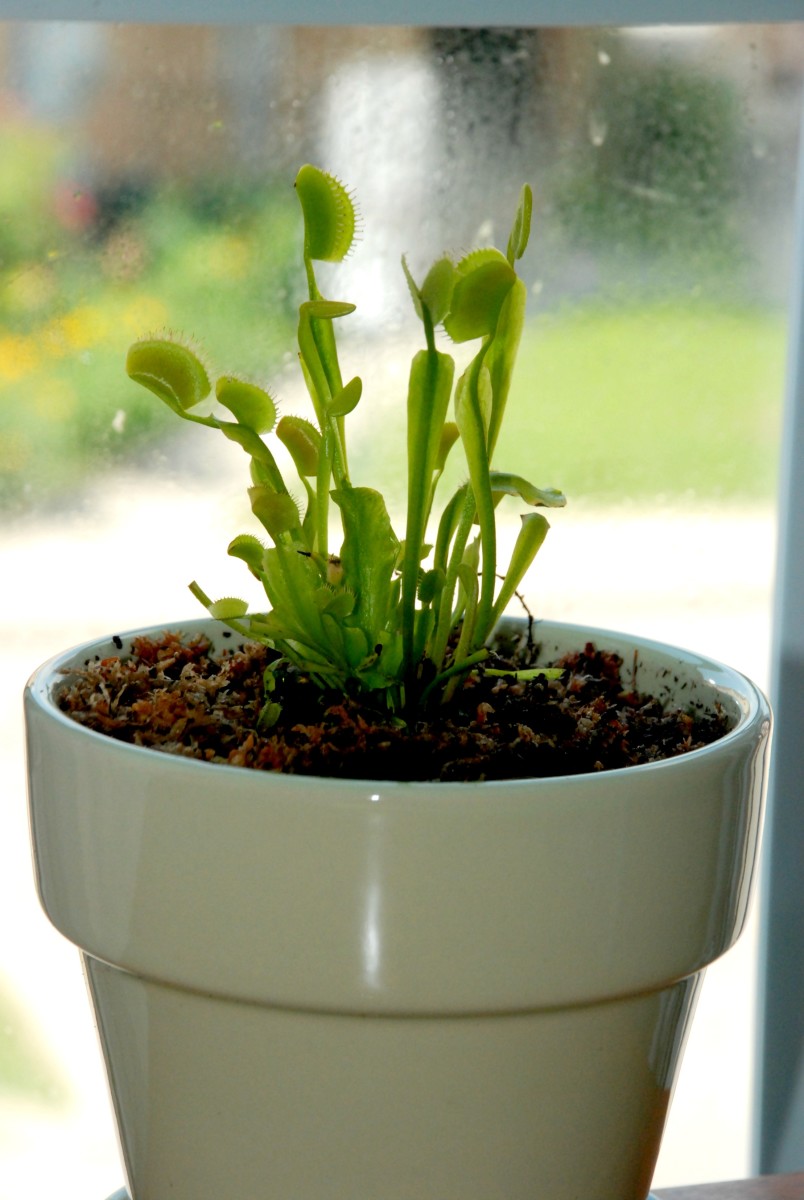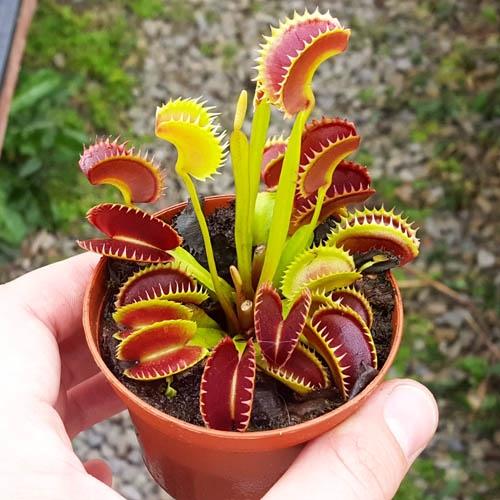
The Venus flytrap (Dionaea muscipula) is a savage plant local to the lowlands of North and South Carolina. In these areas, they develop in sandy soil that is high in dampness and sharpness however supplement inadequate, consequently, the advancement of its insect eating capacity. Flytraps, similar to all plants, get their food from the dirt and through photosynthesis, yet they additionally eat insects to enhance their supplement requests. The capacity to live in unforgiving soil and catch their own food makes Venus flytraps probably the least demanding plant to think about. So, see below how to care for venus fly trap indoors…

How To Care For Venus Fly Trap Indoors:
The most famous carnivorous plant, Venus flytraps develop to 5-6 crawls in width with traps normally matching 1.5 inches. In pre-summer, Venus flytraps produce little white blossoms that promptly self-fertilize. In mid to pre-fall, you can gather seeds once the whole tail turns totally dark and evaporates. Local to a 90-mile span
Plant Them In A Good Drainage Plastic Pot:
Venus flytraps need a great deal of dampness, yet an excess of water in the pot or in their ground can prompt mold development and root decay so plant them in a pot with seepage openings. Despite the fact that they can in any case develop in pots without seepage gaps, this expects you to give more consideration to how a lot and how frequently you water. This is one of the steps on how to care for the venus fly trap indoors.
Additionally, select plastic pots instead of mud or concrete squares. Minerals in the earth or concrete can enter their water flexibly, which can cause mineral consumption.
As your plant develops, you may need to repot it to give it additionally space to breathe. Slowly climb to greater pots. There’s no utilization planting it in an enormous pot imagining that this will cause it to become quicker.
Soil For Venus Flytraps:
As referenced at the start of the article, Venus flytraps are accustomed to developing in undernourished, acidic, and sandy soil. Utilizing a 1:1 proportion by volume of sphagnum peat greenery to agricultural sand is ideal for keeping dampness while as yet giving waste. This is one of the steps on how to care for the venus fly trap indoors.
What Is the Best Soil for Growing Venus Flytraps?
Try not to utilize standard fertilized soil, manure, or any advanced soils or greeneries. Likewise oppose the allurement of utilizing manures to enable them to develop. An over-burden of supplements is really hurtful to the plant.
Utilize plant sand, not sand from the seashore. Sand from the seashore, similar to earth pots, can include an excessive amount of mineral substance and cause your plant to wilt.
Use peat moss and not simply sphagnum greenery. The thing that matters is that sphagnum greenery holds a lot of water and has an unbiased pH. Peat greenery, usually alluded to as sphagnum peat greenery, is more acidic and holds the perfect measure of water, copying the conditions in the flytrap’s characteristic environment.
Use a rock or utilize more sand to give more seepage. Perlite is usually used to circulate air through soils and keep them from hardening. You can likewise have a go at utilizing a 1:2 proportion by volume of peat greenery to sand. This is one of the steps on how to care for the venus fly trap indoors.

Water:
The dirt ought to be kept clammy consistently. Generally, you just need to water like clockwork, yet in the event that you live in dry or hot regions, or in the event that you have bigger pots, you may need to water each day. This is one of the steps on how to care for the venus fly trap indoors.
Be that as it may, be wary of overwatering. Developing in an enormous pot or in dry, hot conditions can cause the surface layer of peat greenery to appear to be dry, yet the more profound layers may at present be sodden.
Just use refined water or water. Faucet water or even sifted water generally contains an excessive number of soluble minerals that will hurt the plant. Recall that they flourish in acidic conditions.
In the event that you are distracted or need more an ideal opportunity to water, one stunt is to placed the pot in a plastic plate, dish, or saucer. Top the plate off with water, and the peat greenery can draw it up after some time like a wipe. This is generally helpful for littler pots or throughout the mid year when the climate is more sizzling than expected. This is one of the steps on how to care for the venus fly trap indoors.

Light:
Venus flytraps can get by in incomplete shade and at least 4 hours of daylight, however in the event that you need them to flourish, furnish them with 12 hours of immediate, splendid daylight. The morning is the best ideal opportunity for this since the beams are not very extraordinary. This is one of the steps on how to care for the venus fly trap indoors.
Dodge direct daylight if it’s excessively sweltering out, such as throughout the late spring, to keep them from consuming or drying out. You can give some shade by hanging some cheesecloth or other light work texture over the plants. You can likewise put them under the shade of taller plants or trees. Simply ensure there is as yet satisfactory daylight getting through the shade.
They can get some daylight inside on the off chance that you place them by a window that approaches direct daylight ordinarily, windows that face east, west, or south. This is one of the steps on how to care for the venus fly trap indoors.
Imagine a scenario where I Don’t Have Access to a Window With Direct Sunlight. On the off chance that you live in a spot that isn’t excessively bright, or you don’t have windows that face the sun, consider putting resources into counterfeit developing lights typically fluorescent or LED lights. Keep the lights near the plant (around 2-8 inches away). Make sure to turn them off the following 12 hours.
Foods For Venus Flytrap:
In the event that you are developing them outside, they can most likely catch their own prey. Notwithstanding, on the off chance that you are developing them inside, or you notice they are looking unfortunate, you can occasionally get them out by taking care of the little insects. This is one of the steps on how to care for the venus fly trap indoors.
Simply try to monitor which traps you have taken care of. You would prefer not to overload them. They can indeed open and close a limited number of times throughout their life, and continued taking care of can sap their energy.
It is ideal to take care of them live creepy crawlies on the grounds that this will help trigger their regular stomach related cycles urea delivered by the bug flags the plant to discharge stomach related juices. Notwithstanding, taking care of them live creepy crawlies can be hard to do and truly isn’t fundamental. Taking care of them dead creepy crawlies is totally satisfactory. This is one of the steps on how to care for the venus fly trap indoors.

What To Feed Them?
As their name recommends, they love eating flies. Notwithstanding, they can eat any bug sufficiently little to trap, for example, mosquitoes, moths, ladybugs, bugs, scarabs, and ants.
On the off chance that you feed them, ensure the bug is around 1/3 the size of the snare. In the event that the creepy crawly is excessively little, the snare may not close completely and may wind up not eating it at all since it won’t give enough supplements. On the off chance that the bug is too huge, the snare can’t close completely, making it harder for the plant to process the creepy crawly and expanding the danger of a bacterial disease (from microscopic organisms amassing on the dead bug). This is one of the steps on how to care for the venus fly trap indoors.
How To Them?
I utilize a long tweezer to hold a bug. The trigger hairs ought to be contacted for the snare to close. Stimulate them a smidgen with the bug’s legs.
Instructions To Care For Venus Flytraps During Dormancy:
Venus flytraps blossom in the spring, develop through the mid year and fall, and go lethargic through the winter (about 3-5 months). They don’t kick the bucket in the winter, in spite of the fact that it might appear as though they are. They simply aren’t making a decent attempt to develop so as to ration energy for the following developing season. This is one of the steps on how to care for the venus fly trap indoors.
This doesn’t mean you can simply disregard them. They actually need daylight and water to perform photosynthesis. Here are a few hints to enable your plant to endure the winter:
The best spot to keep them is outside, however, ensure you don’t live in an area that is vulnerable to icing and freezing. Plants in pots are bound to freeze over, so the best tip is to move them into the ground, where the dirt huge volume of soil can go about as protection that secures the rhizomes. Make sure to utilize acidic, sandy soil that is reasonable for Venus flytraps.
Keep the plants cool, however, don’t permit it to freeze. The ideal temperature extends during torpidity is between 32 ºF and 55 ºF (0 ºC-11 ºC). Be that as it may, it will at present remain torpid at higher temperatures. This is one of the steps on how to care for the venus fly trap indoors.
A few people keep their flytraps in a plastic sack in the cooler for the whole winter. In the event that you decide to do this, eliminate dead leaves (seem earthy colored or dark) and fog with a fungicide to forestall shape and contagious development. Beware of them intermittently to ensure they have enough water
Give them some sun, however less sun than expected. Lethargy is believed to be welcomed by a blend of dropping temperatures and shorter days (a shorter measure of light). Throughout the winter, the plants ought to get under 12 hours of light.
Keep the dirt moist, however, you don’t need to water so a lot. The plant actually needs some water, however, it won’t go through as a lot of it. Screen the dampness of the greenery day by day for the primary week to assist you with measuring how regularly you have to water.
At the point when it emerges from torpidity, slowly increment the measure of daylight, food, and water. This is one of the steps on how to care for the venus fly trap indoors.

Why You Should Take Care of Them During Dormancy?
You can decide to let them pass on over the winter, yet lethargy permits the Venus flytrap to stay solid and solid. Thought about appropriately, they can satisfy around 20 years. This is one of the steps on how to care for the venus fly trap indoors.
How To Repot:
As more snares develop and get greater, give them more space by progressively moving them to bigger and bigger pots. This will give them additional space to breathe both for the snares and the roots. Developing roots can make the sand and greenery conservative, so bigger pots are a smart thought to improve air circulation. This is one of the steps on how to care for the venus fly trap indoors.
Prune Dead or Dying Leaves:
Wiped out, kicking the bucket, or dead leaves and other plant parts are vulnerable to parasitic development that can attack and slaughter the remainder of the plant; it is critical to eliminate them when you notice them. It’s anything but difficult to discern whether the leaves are dead or kicking the bucket: they will be withered, dry, and seem earthy colored or dark.
It’s ideal to prune as ahead of schedule as could reasonably be expected, yet in the event that you overlook, and you notice shape beginning to develop, eliminate the influenced parts immediately and softly splash the plant with a fungicide. This is one of the steps on how to care for the venus fly trap indoors.



